
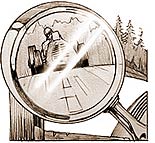
Backward glances at racing history
Atlas F1 Columnist
An Incomplete History and Record of American Racing, with Occasional Diversions by Our Scribe
And, of course, France introduced a term which is now commonplace among those who follow motor sports: grand prix. However, without an American being the catalyst, the history of motor sports could have been rather different. The name of that catalyst was James Gordon Bennett.
Sometimes there are individuals who actually do create the forces of change that lead to paths being taken that would otherwise never have existed or would, naturally, have been very different. Nor are these paths necessarily those which that person - or force or catalyst - would have chosen. Life often works that way. One person that we have left relegated to the dustbin history is the very man who created - willingly or not - the very basis of the world of motor racing that has existed for the past century.
It is said that Jamie Bennett was born with a "silver spoon in his mouth." It is also said that Jamie Bennett turned that spoon into gold during his lifetime. The amount of wealth generated by the Herald was enormous and Jamie Bennett was denied nothing. With his treatment in New York often rough and occasionally violent, the senior Bennett sent Jamie, his sister Jeannette, and their mother to France where the children were to be educated. Thus the family was spared the brandishing by the elder Bennett of the arsenal of weapons that he maintained in his offices at the corner of Ann Street and Broadway and at their home in lower Manhattan.
For his sixteenth birthday, young Jamie received the Rebecca, a 77-ton centerboard sloop with a crew of 22. The 1857 Annual Cruise of the New York Yacht Club (NYYC) consisted of a number of races that season. The evidence of how young Bennett conducted himself and his crew is evidenced by the decision of the captains of the club during a layover in New Bedford to invite him to be a member of the NYYC. At the age of 16 years and three months, Jamie Bennett is still the youngest full member ever of the NYYC. Although the honor was earned, it was not without controversy: the Rebecca was a frequent subject of protests and other heated discussions during the racing season.
In the early days of the War of the Rebellion, the elder Bennett committed the Herald to both the union cause and to the President, Abraham Lincoln. This support was to prove important not only at the time, but later on during the months were the Union tide seemed to be perpetually stalled at the low tide marker. President Lincoln corresponded with the elder Bennett and this correspondence displays the true command with which Lincoln guided the Union cause. In addition to committing his newspaper to the Union war effort, the younger Bennett was also volunteered to serve in the Revenue Cutter Service, known today as the Coast Guard. Commissioned as a Third Lieutenant, Jamie Bennett commanded his new 225-ton schooner, the Henrietta, off the Carolina coast for a year.
Jamie Bennett moved more and more to the foreground in the activities of the Herald. It was the younger Bennett who had the idea to hire foreign correspondents to write for the New York-based newspaper on the events of the world. This was strengthened by the relationship that existed with the Associated Press News Agency, the elder Bennett being the co-founder of the news syndicate. One inspiration that the younger Bennett had which was a measure of his genius for generating news, was the mission of correspondent and "ace reporter" Henry Morton Stanley (who was actually named John Rowlands when he was born in a London orphanage) to "find" the missionary Dr. David Livingstone. This African adventure kept audiences buying newspapers for month after month. For decades afterward, the utterance of, "Doctor Livingstone, I presume?" was to make its rounds in society, both high and low.
His father died in 1872 and left Jamie Bennett in sole command of the Herald at the age of 31. His poor manners in public soon became worse. It was not unusual for Bennett to walk through a restaurant and pull the tablecloths off the tables and then crush the dinnerware underfoot. Or to "trash" hotel rooms, lobbies, or dining rooms as a means of amusement. The bills were always promptly paid and the particulars rarely questioned.
If his father had been a tyrant and a most difficult man to deal with, Jamie Bennett was in many ways worse. He mirrored his father's journalism and pragmatic style in judging what was to be printed. Dizzying reversals of editorial stances were dismissed with the same phrase used by the elder: "I print my paper every day."
However, the office used by Jamie Bennett was soon transferred from New York to Paris. In one of his more notable escapades, Jamie Bennett attended a New Year's Open House hosted by the young lady to whom he may or may not have been engaged, Caroline May, the daughter of Dr. William May. As 1877 celebrated its early hours, so did Jamie Bennett.
The May Open House was merely one of many that a very drunk Jamie Bennett visited, having taken advantage of the spirits available at the various festivities. Although there is some difficulty in ascertaining the exact nature of how it came to be that Jamie Bennett answered the "call of nature" and urinated in the May fireplace in front of all those assembled for the Open House - including Miss Caroline May, there is no doubt of this incident's happening: the following day Miss May's brother confronted Bennett at the Union Club and there was a resulting fistfight which in turn lead to a challenge to a duel.
There is some reason to think that after his opponent deliberately "fired wild," that Jamie took deliberate aim at May - and missed. Whether his faux pas was firing at his opponent after the deliberate miss by May or firing at May and then missing, Bennett was said to have been terminally embarrassed and then removed himself from New York Society. He then left the United States to take up residence in Europe, returning only from time to time on his yachts to visit New York or Newport.
He did import the sport of Polo into the United States in 1876 prior to his self-imposed exile. It was first played at Newport, Rhode Island. In 1878, Bennett imported the leading British team to show everyone how it was done. This also allowed Colonel Candy, the captain of the British team, to ride one of his polo ponies up the stairs to the Reading Room club in Newport, which was done so as part of a wager by Bennett. When the Reading Room removed Bennett from its membership rolls, Jamie simply built the Casino - what could be considered as the first sports complex - on Bellevue Avenue. Bennett also once cast into the fireplace a wad of Franc bills that were in his back pocket and prevented from sitting comfortably and enjoying his cigar and brandy.
His social embarrassment did not carry over very far into yachting circles, obviously, but he since served two terms as the Commodore of the NYYC - still the only man to ever do so. His yacht collection was easily that of the navies of many of the lesser nations of Europe. The names of the yachts are numerous and the sizes usually enormous, but it is the Lysistrata that usually captures the imagination. Over 300 feet long, a crew of over one hundred, and an "owner's suite" of lavish size on each of its three decks, in addition to the guest suites and crews quarters, it was the very personification of what being filthy rich was all about. It also had a special cabin which housed a padded stall for the ship's cow (an Alderney) so that fresh milk and cream could be available for the dinner table.
It also had something which brings us, finally, to the point of this diversion: a shipboard garage for an automobile, originally a de Dion-Bouton.
Given his interest in all things nautical and technology in general, that Gordon Bennett was attracted to the motor car should not be a surprise. He was later to sponsor events and cups for such transportation-related activities as horse racing, ballooning, yacht racing, steam boats, bicycling, motor boating, and heavier-than-air aviation. The Fédération Aéronautique Internationale still awards the Coupe Aeronautique "Gordon Bennett" even today as the premier event in the sport of ballooning.
In late 1899, Gordon Bennett began to see the potential for automotive competition as means to not only advance automotive technology, but to increase the circulation of the Herald. As both a founding member of the ACF in November 1895, and as a man of considerable means, when Gordon Bennett suggested to the leaders of the ACF that there should be an international competition of automobiles, pitting the best of each nation against that of other nations, his idea was given close attention and serious consideration.
Gordon Bennett commissioned a silversmith in Paris, Andre Aucoc, to fashion a suitable trophy for what was to be known as the Coupe Internationale. Although usually called the "Gordon Bennett Cup," the trophy Gordon Bennett set before the ACF was 17 kilograms of silver which featured a contemporary automobile with Winged Victory standing upon the seat and another figure - said to be the Goddess of Speed - stretched out over the front of the automobile. It was, to say the least, impressive.
Gordon Bennett dictated what the rules were to be: the entrants were to be nominated through the various national automobile clubs of the day - with the stipulation that the Automobile Club of Torino would be the Italian representative since there was no national club at that time. Nor was there one in the United States, but the Automobile Club of America (ACA) was hurriedly organized for that purpose. These entrants were to compete as national teams, not as manufacturer teams, against the teams nominated by the other national automobile clubs. The components of the automobiles entered had to be entirely produced in the nation which it was representing.
There was a deposit of 3,000 Francs required of each club wishing to enter the competition, due not later than January 1st 1900. Even before the deposits were due, racing colors were being assigned to the nations that might enter the competition: France, blue; Germany, white; Belgium, yellow; Italy, black; Great Britain and Ireland, green; and, the United States would use red.
Things did not go well when only a trickle of entries arrived for the Coupe Internationale. Then there were problems with getting the race to take place as scheduled when a racing accident caused an uproar in the government with there being a ban on all motor racing imposed literally only days prior to the race. This was eventually resolved, but not without much discussion and the threat to move the entire proceeding to Italy - echoes of the days when Italy was the favored battleground of the monarchies. Only the ACF fielded a complete team, which was to be expected. The ACF team was composed of three Panhard 40 machines driven by Rene de Kynff, Fernand Charron, and Leonce Girardot. However, the irritation of other French manufacturers was already showing and Mors ran "Levegh" as an "official" entry.
The race finally did get underway, but only after the Automobil Club von Deutschland's entry, Eugen Benz in a machine of his own manufacture, was scratched due to tire problems, and an American entry, Anthony Riker in a Winston, was also scratched. The other entries besides the ACF team, were the ACA entrant Alexander Winston in one of his own machines - which while competitive in America was woefully off pace in France, and the Automobile Club de Belgique entry of a Snoek-Bolide for Camille Jenatzy.
However, despite the event running until 1905 with varying levels of success and support, it was the problems of the Coupe Internationale which led to the path that was taken, which was not the one offered by Gordon Bennett. Gordon Bennett and many of his contemporaries were advocates of nationalistic games. Recall, for example, that in 1896 the Olympic Games were revived as a means of competition between national organizing committees.
However, although the Gordon Bennett Cup rules staggered on with some changes or tinkering, the French manufacturers were becoming more and more exasperated with the Coupe Internationale and their discontent was spreading. The restriction to a contest of a national team with only three entries meant that many of the French entries being left out of the competition were superior to those of the "foreign" teams contesting the events. On top of this, the ACF was tiring of the heavy-handedness of Gordon Bennett himself, who saw no problems and liked things pretty much as they were. Since it was his Coupe Internationale, he felt entitled to run it as he did his newspaper: his way.
One outcome of the competition was the meeting held in the aftermath of the 1904 running of the Coupe Internationale in Homburg. The representatives of the various national clubs present - the Automobil Club von Deutschland, the Automobile Club of Great Britain and Ireland, the Osterreiche AS Clun, the Automobil Club d'Italia, the Automobile Club de France, the Automobile Club de Belgique, the Automobile Club de Suisse - decided that there was a need for an international arrangement to be made for the better communication between the clubs of items of shared interest in the motoring arena as well as for those items which related to the sporting elements of motoring.
By 1905, the discontent over the regulations governing the Coupe Internationale had reached a point where the ACF decided that enough was enough and finally created its own international motoring competition which focused on the manufacturers (and drivers…) rather than the national industries. Although originally scheduled for 1905, the Automobile Club de France finally put everything into place and using the Circuit de la Sarthe outside Le Mans for two days of racing in late June 1906 changed the face of international racing.
On 26 and 27 June 1906, the first Grand Prix de l'Automobile Club de France was held and changed the focus of international racing from national teams composed of a mixture of indigenous manufacturers using only native components to a contest of manufacturers and teams bent solely on winning - using whatever it took from wherever it could be found.
As for Gordon Bennett, he took things in stride and shifted from auto racing to balloons and then airplanes. He was never one to dwell on things, very much a man of the moment. However, although it had been his intention to create an international racing series, it eventually came to pass even if not exactly as he envisioned it.
Gordon Bennett died at his estate on the Cote d'Azur, Beaulieu-sur-Mer, on May 14th 1918, just days after his 77th birthday. Among his heritage, willingly or not, he left us with the modern racing world of the Grands Prix and the FIA and its World Federation of Motor Sport.
References:
For many reasons that make perfect sense, along with some that defy any logic, France was The Star of the show and standing tall at center stage during the dawn of the automobile age. It held most of the early automotive competitions, organized the first true national automobile club - the Automobile Club de France (ACF) in November 1895 - and was the leading manufacturer of automobiles in the early days of the 20th Century.
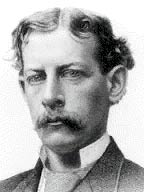 James Gordon Bennett, Junior - "Jamie' - was born in New York on 10 May 1841. His father was the editor, proprietor, and driving force behind the newspaper that changed the very nature of what a newspaper was in America: the New York Herald. The senior James Gordon Bennett created the first of the American newspapers which could truly be considered as a "mass circulation" newspaper. Bennett changed it from being a gazette of the various events of the day to a provider of "news," in whatever grand or ghastly form it came in. It also sold for a single penny, which brought it within reach of virtually anyone's ability to pay. It was a rousing success and made James Gordon Bennett Sr a very rich man.
James Gordon Bennett, Junior - "Jamie' - was born in New York on 10 May 1841. His father was the editor, proprietor, and driving force behind the newspaper that changed the very nature of what a newspaper was in America: the New York Herald. The senior James Gordon Bennett created the first of the American newspapers which could truly be considered as a "mass circulation" newspaper. Bennett changed it from being a gazette of the various events of the day to a provider of "news," in whatever grand or ghastly form it came in. It also sold for a single penny, which brought it within reach of virtually anyone's ability to pay. It was a rousing success and made James Gordon Bennett Sr a very rich man.
 It was at the conclusion of his year of wartime service that Jamie Bennett the playboy and rising force at the Herald came to the fore. He became one of the lions of society, frequenting the Union Club, Delmonico's, and other society haunts. His behavior was often the talk of the town. He was proved to be very much his father's son and in the latter part of the 1860s moved more and more to the fore in the running of the Herald. The father and son not only shared their office at the newspaper, but also their mansion on lower Fifth Avenue and their estate on 181st Street. The financial situation at the Herald improved from excellent to even better than excellent: Jamie Bennett had a disposable income - as we would refer to it today - of about one million dollars a year. In addition to his homes in New York, Jamie Bennett maintained a residence in Paris.
It was at the conclusion of his year of wartime service that Jamie Bennett the playboy and rising force at the Herald came to the fore. He became one of the lions of society, frequenting the Union Club, Delmonico's, and other society haunts. His behavior was often the talk of the town. He was proved to be very much his father's son and in the latter part of the 1860s moved more and more to the fore in the running of the Herald. The father and son not only shared their office at the newspaper, but also their mansion on lower Fifth Avenue and their estate on 181st Street. The financial situation at the Herald improved from excellent to even better than excellent: Jamie Bennett had a disposable income - as we would refer to it today - of about one million dollars a year. In addition to his homes in New York, Jamie Bennett maintained a residence in Paris.
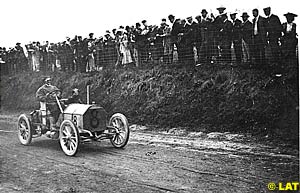 With duels being even then a rather archaic practice, it was finally arranged that such a duel be conducted just south of the Maryland-Delaware border. With a host of surgeons and seconds in waiting, the two men marched off their twelve paces and… here the stories differ. Most have it that both "fired wild" - as the term goes - to signify that honor had been satisfied. However, there is reason to believe that this was not the case. Although all accounts seem to agree that Miss May's brother did indeed "fire wild," it is in Jamie Bennett's behavior that we find differences.
With duels being even then a rather archaic practice, it was finally arranged that such a duel be conducted just south of the Maryland-Delaware border. With a host of surgeons and seconds in waiting, the two men marched off their twelve paces and… here the stories differ. Most have it that both "fired wild" - as the term goes - to signify that honor had been satisfied. However, there is reason to believe that this was not the case. Although all accounts seem to agree that Miss May's brother did indeed "fire wild," it is in Jamie Bennett's behavior that we find differences.
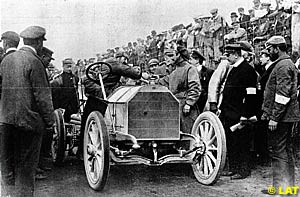 After establishing a European office for the Herald in Paris and using the new transoceanic cable to transmit stories and orders to the New York office, Jamie Bennett increasingly began to refer to himself as "Gordon Bennett." His office staff fell into line very quickly with this practice and so that is also why the various trophies he sponsored were called the "Gordon Bennett" cup or trophy and not the "Bennett" cup or trophy.
After establishing a European office for the Herald in Paris and using the new transoceanic cable to transmit stories and orders to the New York office, Jamie Bennett increasingly began to refer to himself as "Gordon Bennett." His office staff fell into line very quickly with this practice and so that is also why the various trophies he sponsored were called the "Gordon Bennett" cup or trophy and not the "Bennett" cup or trophy.
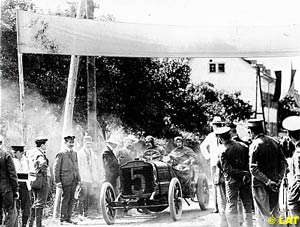 The event, the I Coupe Internationale, was to be held between 15 May and 16 August of 1900, over a circuit chosen by the ACF covering a distance not to exceed 650 kilometers and not less than 550 kilometers. The automobiles had to weigh at least 400 kilograms, but not exceed 1,000 kilograms - the weight being measured without driver or co-driver, fuel, lubricants. Coolants, battery, tools, luggage, extra clothing, or foodstuffs. There were no restrictions on the engines used as to size, fuel, type, or fuel consumption.
The event, the I Coupe Internationale, was to be held between 15 May and 16 August of 1900, over a circuit chosen by the ACF covering a distance not to exceed 650 kilometers and not less than 550 kilometers. The automobiles had to weigh at least 400 kilograms, but not exceed 1,000 kilograms - the weight being measured without driver or co-driver, fuel, lubricants. Coolants, battery, tools, luggage, extra clothing, or foodstuffs. There were no restrictions on the engines used as to size, fuel, type, or fuel consumption.
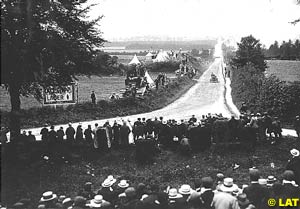 There were few spectators along the Paris to Lyons route and fewer yet to witness the massed start, something which was to be a rarity in Europe until well into the 1920s. Despite no end of problems by all the entrants - such as broken wheels, gearboxes without gears, large animals, trees, and the sorry state of the road itself - there was a winner: Charron in a Panhard.
There were few spectators along the Paris to Lyons route and fewer yet to witness the massed start, something which was to be a rarity in Europe until well into the 1920s. Despite no end of problems by all the entrants - such as broken wheels, gearboxes without gears, large animals, trees, and the sorry state of the road itself - there was a winner: Charron in a Panhard.
 The result was the formation of an organization, the Association Internationale des Automobile Clubs Reconnu or AIACR, which changed its name in 1946 to become the Federation Internationale Automobile or the FIA. The American representative to the AIACR at this time was the Automobile Club of America.
The result was the formation of an organization, the Association Internationale des Automobile Clubs Reconnu or AIACR, which changed its name in 1946 to become the Federation Internationale Automobile or the FIA. The American representative to the AIACR at this time was the Automobile Club of America.

Please Contact Us for permission to republish this or any other material from Atlas F1.
|
Volume 8, Issue 03
Articles
Rear View Mirror
Toyota Never Won Le Mans
Premature Engagement
The Juan and Only
Columns
Bookworm Critique
The Weekly Grapevine
> Homepage |